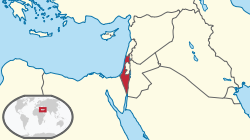Ísráẹ́lì
Appearance
(Àtúnjúwe láti Israel)
Orile-ede Israel State of Israel מְדִינַת יִשְׂרָאֵל (Hébérù) Medīnat Yisrā'el دَوْلَةُ إِسْرَائِيلَ (Lárúbáwá) Dawlat Isrā'īl | |
|---|---|
Orin ìyìn: Hatikvah The Hope | |
 | |
| Olùìlú àti ìlú tótóbijùlọ | Jerusalem[1] 31°47′N 35°13′E / 31.783°N 35.217°E |
| Àwọn èdè ìṣẹ́ọba | Hebrew, Arabic[2] |
| Àwọn ẹ̀yà ènìyàn | 75.4% Jewish, 20.6% Arab, 4% minority groups[3] |
| Orúkọ aráàlú | Israeli |
| Ìjọba | Republic under Parliamentary democracy[2] |
| Isaac Herzog (יצחק הרצוג) | |
| Benjamin Netanyahu (בנימין נתניהו) | |
| Mickey Levy (מיקי לוי) | |
| Esther Hayut (אסתר חיות) | |
| Independence | |
| May 14, 1948 | |
| Ìtóbi | |
• Total | 20,770–22,072 km2 (8,019–8,522 sq mi)[a] (150th) |
• Omi (%) | 2.1 |
| Alábùgbé | |
• 2024 estimate | Àdàkọ:Data Israel[4] (99th) |
• 2008 census | 7,412,200[5] |
• Ìdìmọ́ra | [convert: invalid number] (35th) |
| GDP (PPP) | 2020[8] estimate |
• Total | ▲ $372.314 billion{{refn|group=fn|name=oecd|Israeli population and economic data covers the economic territory of Israel, including the Golan Heights, East Jerusalem and Israeli settlements in the West Bank.[6][7]} (51st) |
• Per capita | ▲ $40,336 (34th) |
| GDP (nominal) | 2020[8] estimate |
• Total | ▲ $410.501 billion (31st) |
• Per capita | ▲ $44,474 (19th) |
| Gini (2018) | 34.8[9] medium · 48th |
| HDI (2019) | ▲ 0.919[10] very high · 19th |
| Owóníná | Shekel (₪) (ILS or NIS) |
| Ibi àkókò | UTC+2 (IST) |
• Ìgbà oru (DST) | UTC+3 (IDT) |
| Ojúọ̀nà ọkọ́ | right |
| Àmì tẹlifóònù | 972 |
| ISO 3166 code | IL |
| Internet TLD | .il |
| |
Israel (Àdàkọ:Lang-he-n, Yisra'el; Lárúbáwá: إِسْرَائِيلُ, Isrā'īl) tabi Orile-ede Israel je orile-ede ni Arin Ilaoorun.

|
Àyọkà yìí tàbí apá rẹ̀ únfẹ́ àtúnṣe sí. Ẹ le fẹ̀ jù báyìí lọ tàbí kí ẹ ṣàtúnṣe rẹ̀ lọ́nà tí yíò mu kúnrẹ́rẹ́. Ẹ ran Wikipedia lọ́wọ́ láti fẹ̀ẹ́ jù báyìí lọ. |
Itokasi[àtúnṣe | àtúnṣe àmìọ̀rọ̀]
- ↑ The Jerusalem Law states that "Jerusalem, complete and united, is the capital of Israel" and the city serves as the seat of the government, home to the President's residence, government offices, supreme court, and parliament. The United Nations and all member nations, in accordance with United Nations Security Council Resolution 478 (Aug. 20, 1980; 14–0, U.S. abstaining) which declares the Jerusalem Law "null and void" and calls on member states to withdraw their diplomatic missions from Jerusalem, refuse to accept the Jerusalem Law (see Kellerman 1993, p. 140) and maintain their embassies in other cities such as Tel Aviv, Ramat Gan, and Herzliya (see the [1] Archived 2021-01-03 at the Wayback Machine. CIA Factbook and Map of Israel). The Palestinian Authority sees East Jerusalem as the capital of a future Palestinian state and the city's final status awaits future negotiations between Israel and the Palestinian Authority (see "Negotiating Jerusalem", University of Maryland Archived 2006-05-14 at the Wayback Machine.). See Positions on Jerusalem for more information.
- ↑ 2.0 2.1 Àṣìṣe ìtọ́kasí: Invalid
<ref>tag; no text was provided for refs namedcia - ↑ "Ẹda pamosi". Archived from the original on 2009-12-03. Retrieved 2009-09-26.
- ↑ "Home page". Israel Central Bureau of Statistics. Retrieved 20 February 2017.
- ↑ Population Census 2008. Israel Central Bureau of Statistics. 2008. http://www.cbs.gov.il/www/mifkad/mifkad_2008/profiles/rep_e_000000.pdf. Retrieved 27 December 2016.
- ↑ OECD 2011.
- ↑ Quarterly Economic and Social Monitor Archived 2021-10-09 at the Wayback Machine., Volume 26, October 2011, p. 57: "When Israel bid in March 2010 for membership in the 'Organization for Economic Co-operation and Development'... some members questioned the accuracy of Israeli statistics, as the Israeli figures (relating to gross domestic product, spending and number of the population) cover geographical areas that the Organization does not recognize as part of the Israeli territory. These areas include East Jerusalem, Israeli settlements in the West Bank and the Golan Heights."
- ↑ 8.0 8.1 "World Economic Outlook Database, October 2019". International Monetary Fund. Retrieved 23 March 2020.
- ↑ "Income inequality". data.oecd.org. OECD. Retrieved 29 June 2020.
- ↑ Nations, United (15 December 2020). Human Development Report 2020 The Next Frontier: Human Development and the Anthropocene. United Nations Development Programme. pp. 343–346. ISBN 978-92-1-126442-5. http://hdr.undp.org/sites/default/files/hdr2020.pdf. Retrieved 16 December 2020.
Àwọn ẹ̀ka:
- Pages using duplicate arguments in template calls
- Pages with malformed coordinate tags
- Pages with reference errors
- Webarchive template wayback links
- Pages containing cite templates with deprecated parameters
- Convert errors
- Pages using infobox country with unknown parameters
- Pages using infobox country or infobox former country with the symbol caption or type parameters
- Articles containing Arabic-language text
- Ísráẹ́lì
- Àwọn orílẹ̀-èdè Ásíà


